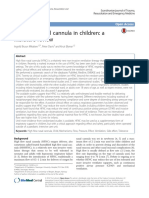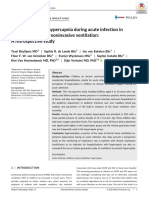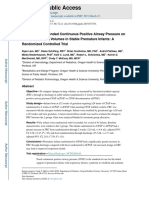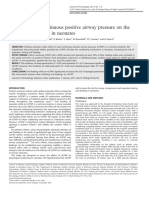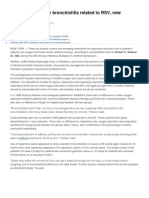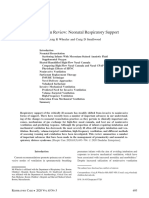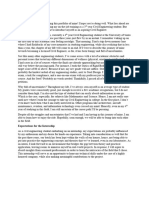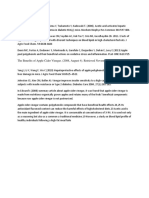Respcare 05961 Full
Respcare 05961 Full
Uploaded by
Wuppuluri Jayanth Kumar SharmaCopyright:
Available Formats
Respcare 05961 Full
Respcare 05961 Full
Uploaded by
Wuppuluri Jayanth Kumar SharmaOriginal Title
Copyright
Available Formats
Share this document
Did you find this document useful?
Is this content inappropriate?
Copyright:
Available Formats
Respcare 05961 Full
Respcare 05961 Full
Uploaded by
Wuppuluri Jayanth Kumar SharmaCopyright:
Available Formats
RESPIRATORY CARE Paper in Press. Published on March 13, 2018 as DOI: 10.4187/respcare.
05961
High-Flow Nasal Cannula in Pediatric Patients:
A Survey of Clinical Practice
Andrew G Miller RRT RRT-ACCS RRT-NPS, Michael A Gentle MBA RRT FAARC,
Lisa M Tyler MHS RRT RRT-NPS, and Natalie Napolitano MPH RRT RRT-NPS FAARC
BACKGROUND: High-flow nasal cannula (HFNC) use has greatly increased in recent years. In
non-neonatal pediatric patients, there are limited data available to guide HFNC use, and clinical
practice may vary significantly. The goal of this study was to evaluate current HFNC practice by
surveying practicing pediatric respiratory therapists. METHODS: A survey instrument was posted
on the American Association for Respiratory Care’s AARConnect online social media platform in
March 2017. Paper versions of the survey were also distributed at the annual Children Hospitals
Association meeting. RESULTS: There were 63 responses, of which 98% used HFNC. HFNC was
defined as any heated gas delivered by nasal cannula by 49% of respondents, whereas 21% defined
HFNC as heated gas delivered via nasal cannula at flow greater than or equal to the patient’s
inspiratory demand, and 16% defined HFNC as any gas delivered via nasal cannula above pre-
defined thresholds. Initial flow was set per provider orders by 34% of respondents, per respiratory
therapist-driven protocol by 28%, per patient weight by 15%, per patient age by 15%; 5% of
respondents used other methods. Noninvasive ventilation or CPAP was used by 88% of respondents
as the next step for patients who failed HFNC, with 7% opting for intubation and 5% using other
interventions. Aerosol therapy was delivered by 75% of respondents during HFNC, with 77% of
these respondents delivering aerosol via vibrating mesh nebulizer. During aerosol therapy, 13% of
respondents decreased HFNC flow, while 23% removed patients from HFNC. CONCLUSION:
There was no consensus on the definition of HFNC, how to set initial flow, or how to make
adjustments. Aerosols were delivered by 75% of respondents, predominantly via a vibrating mesh
nebulizer placed on the dry side of the humidifier. The definition of HFNC, how to set flow, and
aerosolized medication delivery are areas in which more research is needed. Key words: high-flow
nasal cannula; pediatrics; aerosol therapy; children. [Respir Care 0;0(0):1–•. © 0 Daedalus Enterprises]
Introduction dries the nasal mucosa and increases upper-airway resis-
tance.2 Technological advances, ease of use, and relative
High-flow nasal cannula (HFNC) use has greatly in- low cost, combined with the widespread availability of
creased in recent years. High-flow gas is defined as a flow commercial systems, has contributed to the increased use
that meets or exceeds the patient’s inspiratory flow.1 With- of HFNC. HFNC has been shown to have several benefi-
out heated humidity, the amount of gas flow delivered via cial physiologic effects, including washout of anatomic
nasal cannula is limited due to poor patient tolerance as it dead space, more consistent FIO2 delivery, improved pa-
tient tolerance, and low levels of PEEP.3,4
Mr Miller and Mr Gentle are affiliated with Duke University Medical
Center, Durham, North Carolina. Ms Tyler and Ms Napolitano are affil-
iated with The Children’s Hospital of Philadelphia, Philadelphia, Penn-
sylvania.
Correspondence: Andrew G Miller RRT RRT-ACCS RRT-NPS, Duke
The authors have disclosed no conflicts of interest. University Medical Center, Respiratory Care Services, PO Box 3911,
2301, Erwin Rd, Durham, NC 27710. E-mail: andrew.g.miller@duke.edu.
Supplementary material related to this paper is available at http://
www.rcjournal.com. DOI: 10.4187/respcare.05961
RESPIRATORY CARE • ● ● VOL ● NO ● 1
Copyright (C) 2018 Daedalus Enterprises ePub ahead of print papers have been peer-reviewed, accepted for publication, copy edited
and proofread. However, this version may differ from the final published version in the online and print editions of RESPIRATORY CARE
RESPIRATORY CARE Paper in Press. Published on March 13, 2018 as DOI: 10.4187/respcare.05961
HFNC USE BY RTS CARING FOR PEDIATRIC PATIENTS
A recent systematic review and meta-analysis5 in adults
found HFNC to be associated with a reduction in intuba- QUICK LOOK
tion rates similar to noninvasive ventilation (NIV) when Current knowledge
compared with conventional oxygen therapy, but no
High-flow nasal cannula (HFNC) use has greatly in-
changes in ICU length of stay or mortality were reported.
creased in recent years. In non-neonatal pediatric pa-
The authors concluded that HFNC is an acceptable alter-
tients, limited data are available to guide HFNC use,
native to NIV in certain clinical situations. A Cochrane
and clinical practice may vary significantly.
review of studies involving premature neonates found
HFNC to be equivalent to CPAP regarding mortality, de- What this paper contributes to our knowledge
velopment of chronic lung disease, and extubation failure,
although HFNC was associated with less nasal trauma.6 There was no consensus on the definition of HFNC,
However, a more recent randomized controlled trial7 found how to set initial flow, or how to make adjustments.
that infants receiving HFNC as primary support were more Failure of HFNC resulted in escalation to noninva-
likely to develop treatment failure within 72 h when com- sive ventilation or CPAP for 88% of respondents.
pared to those who received CPAP. A retrospective anal- Aerosols were delivered by 75% of respondents, pre-
ysis of a large premature neonatal database found that, dominantly via a vibrating mesh nebulizer placed on
compared to CPAP, HFNC was associated with an in- the dry side of the humidifier.
creased risk of death, bronchopulmonary dysplasia, de-
layed oral feeding, and increased hospital length of stay
for infants ⬍ 1 kg.8
ratory Care (AARC) AARConnect online social media
Randomized controlled trials in pediatric subjects are
platform in March 2017. Paper versions of the survey were
relatively limited, with a recent Cochrane review being
distributed at the annual Children Hospitals Association
unable to make any recommendations due to no studies
(CHA) meeting. Paper surveys were entered into REDCap by
meeting their entry criteria.9 There has been one random-
one of the authors. The survey was approved by the AARC
ized controlled trial in infants post cardiac surgery and
board of directors for distribution via AARConnect and ap-
several in infants with bronchiolitis.10-12 Testa et al,10 who
proved for exemption by the Children’s Hospital of Philadel-
studied infants post cardiac surgery, found no change in
phia’s Institutional Review Board. Responses from the AAR-
PaCO2 and an increase in PaO2 when HFNC was compared
Connect and CHA were analyzed for differences in clinical
to low-flow nasal cannula. In infants with bronchiolitis,
practice and are summarized in supplementary materials (see
Milesi et al11 found that HFNC performed worse than
the supplementary materials at http://www.rcjournal.com).
CPAP in infants admitted to the pediatric ICU. Kepreotes
More than one respondent was allowed per institution.
et al12 found that HFNC resulted in longer time spent on
The survey included questions about hospital and re-
oxygen therapy among infant subjects with mild to mod-
spondent demographics, initial HFNC flow setting, adjust-
erate bronchiolitis when compared to standard oxygen ther-
ments, locations where HFNC is used, frequency of as-
apy. Randomized controlled trials in other disease states
sessments, parameters evaluated during assessments, and
are currently unavailable.
aerosol delivery via HFNC if used (see the supplementary
Due to the limited availability of data to guide HFNC
materials at http://www.rcjournal.com). Data were ana-
use, we hypothesized that HFNC practice would vary sig-
lyzed using SPSS version 24 (IBM, Chicago, Illinois).
nificantly between respondents. In particular, the defini-
Chi-square tests and unpaired t tests were performed for
tion of HFNC, how to set flow, and how to deliver aero-
categorical and continuous data, respectively.
solized medications are areas in which more data are clearly
needed. We designed a survey administered to practicing
respiratory therapists (RTs) to evaluate current HFNC prac- Results
tices in pediatric patients.
There were 36 responses from AARConnect and 27
Methods paper surveys from the CHA; 98% of respondents in-
dicated use of HFNC. Respondent demographics are
After a literature review, we designed a survey instru- summarized in Table 1. There were no respondents with
ment using REDCap. The survey instrument was then sent identical demographic data. CHA respondents were more
to 5 colleagues from different centers with experience in likely to be from standalone children’s hospitals com-
HFNC use and survey research for feedback. Changes pared to respondents on AARConnect (100% vs 28%,
were made based on their feedback, and the survey was P ⬍ .001) or to be a manager/director (89% vs 44%,
then posted on the neonatal/pediatric, management, and P ⬍ .001). CHA respondents were more likely than
help line sections of the American Association for Respi- AARConnect respondents to use HFNC in neonates
2 RESPIRATORY CARE • ● ● VOL ● NO ●
Copyright (C) 2018 Daedalus Enterprises ePub ahead of print papers have been peer-reviewed, accepted for publication, copy edited
and proofread. However, this version may differ from the final published version in the online and print editions of RESPIRATORY CARE
RESPIRATORY CARE Paper in Press. Published on March 13, 2018 as DOI: 10.4187/respcare.05961
HFNC USE BY RTS CARING FOR PEDIATRIC PATIENTS
Table 1. Respondent Demographics
Demographics AARConnect Children’s Hospital Association Total P
Respondents, n 36 27 63
Number of beds, mean ⫾ SD 84 ⫾ 91 346 ⫾ 127 198 ⫾ 169 ⬍.001
Number of PICU beds, mean ⫾ SD 21 ⫾ 26 130 ⫾ 121 66 ⫾ 96 ⬍.001
Standalone children’s hospital, n (%) 10 (28%) 27 (100%) 37 (59%) ⬍.001
Tertiary/academic center, n (%) 23 (64%) 22 (81%) 45 (71%) .10
Role, n (%)
Manager/director 16 (44%) 24 (89%) 40 (63%) .001
Supervisor/clinical specialist 9 (25%) 1 (4%) 10 (16%)
Other 2 (13%) 2 (7%) 4 (6%)
Staff therapist 9 (25%) 0 (0%) 9 (14%)
Use HFNC, n (%) 35 (97%) 27 (100%) 62 (98%) .38
Neonates 31 (85%) 27 (100%) 58 (86%) .044
Pediatrics 32 (89%) 27 (100%) 59 (94%) .07
Adults 28 (78%) 12 (44%) 40 (63%) .007
Where HFNC is used, n (%)
Emergency department 29 (81%) 26 (96%) 55 (87%) .063
Regular floors 21 (58%) 20 (74%) 41 (65%) .20
Step-down or intermediate care 27 (75%) 19 (70%) 46 (73%) .68
ICU 33 (92%) 27 (100%) 60 (95%) .12
HFNC ⫽ high-flow nasal cannula
PICU ⫽ pediatric intensive care unit
(100% vs 85%, P ⫽ .044), and less likely to use HFNC Discussion
in adults (44% vs 78%, P ⫽ .007). There were no sta-
tistically significant differences in location of HFNC
In this survey of RTs, there was no consensus for the
use. There were no statistically significant differences
definition of HFNC in pediatric patients, or how to set or
in clinical practice between the AARC and CHA re-
adjust flow. Most respondents used CPAP or NIV when
spondents. Individual differences are included in the
patients failed HFNC. Most respondents indicated that RTs
online supplemental materials (see the supplementary
assessed patients every 4 h. More than three quarters of
materials at http://www.rcjournal.com).
respondents delivered aerosol therapy via HFNC, and most
Disease states, parameters monitored during RT assess-
used a vibrating mesh nebulizer placed on the dry side of
ments, and frequency of assessments based on patient lo-
the humidifier.
cation are summarized in Table 2. Data on the definition of
HFNC was defined as any heated gas delivered by nasal
HFNC, initial HFNC setting, adjustments, and what is
cannula for 49% of respondents, while 21% indicated they
generally done when the patient is failing HFNC are sum-
set the flow at or above the patient’s inspiratory flow.
marized in Table 3.
Importantly, no respondents indicated that they used a
Aerosol therapy was delivered by 75% of respondents
scientifically validated method to ensure set flow was
during HFNC. Of these, 77% delivered aerosols via a
greater than or equal to the patient’s inspiratory flow. Walsh
vibrating mesh nebulizer, 6% via a jet nebulizer, 13%
and Smallwood13 have put forth a method to approximate
decreased HFNC flow, and 23% took the patient off the initial flow setting for HFNC based on the patient’s
HFNC to deliver treatment with a metered-dose inhaler age and weight; to our knowledge, however, this method
or jet nebulizer. Medications delivered via aerosol ther- has not been validated in clinical practice.
apy included 2 agonists for 92% of respondents, cor- Clearly defining HFNC is important because a standard
ticosteroids for 50%, mucolytics for 44%, other medi- definition for HFNC would allow clinicians to compare pa-
cations for 4%, and one respondent indicated they tient outcomes across centers, to provide standard definitions
delivered all respiratory medications, including epopro- for clinical trials, and to provide program benchmarking. The
stenol, via aerosol therapy. The nebulizer was placed on use of a clear definition of HFNC has important patient safety
the dry side of the humidifier by 60% of respondents, on implications as well, because many centers require patients
the wet side of the humidifier by 6%, and between the on HFNC to be in the ICU environment. Determining which
circuit and the cannula by 17%. patient populations, set flows, and FIO2 requirements are safe
RESPIRATORY CARE • ● ● VOL ● NO ● 3
Copyright (C) 2018 Daedalus Enterprises ePub ahead of print papers have been peer-reviewed, accepted for publication, copy edited
and proofread. However, this version may differ from the final published version in the online and print editions of RESPIRATORY CARE
RESPIRATORY CARE Paper in Press. Published on March 13, 2018 as DOI: 10.4187/respcare.05961
HFNC USE BY RTS CARING FOR PEDIATRIC PATIENTS
Table 2. Patient Characteristics and Frequency of RT Assessments Table 3. Respondent Survey Responses
Respondents, Survey Responses n (%)
Patient Characteristics
n (%)
A. How do you define HFNC?
Diseases in which HFNC is used Any heated/humidified and blended gas 31 (49)
Bronchiolitis 59 (95) delivered via nasal cannula
Asthma 41 (66) Heated gas delivered via nasal cannula at flow 13 (21)
Pneumonia 47 (76) greater or equal to the patient’s inspiratory
Postoperative 33 (53) demand
ARDS 30 (48) Nasal cannula flow above predefined thresholds 10 (16)
Parameters monitored during RT assessments based on the patient’s age or weight
Breathing frequency 62 (100) Other/no response 6 (10)
Heart rate 48 (77) B. What method is used to set flow?
Heart rate via continuous ECG 41 (66) Per provider orders 21 (34)
Work of breathing 53 (85) Per RT-driven protocol 17 (28)
Blood pressure 12 (19) Weight-based (eg, 1 L/kg/min) 9 (15)
Pulse oximetry (SpO2) 60 (97) Age based (different flow for different ages) 9 (15)
Transcutaneous CO2 10 (16) Other 3 (5)
Near infrared spectroscopy 3 (5) C. How is flow adjusted?
Per RT-driven protocol 22 (36)
Frequency of RT Assessments
On the basis of vital signs (breathing frequency, 21 (34)
Emergency department
heart rate, work of breathing)
Every 2 h 22 (41)
Per provider orders 15 (25)
Every 4 h 19 (35)
Other 3 (5)
Every 6 h 1 (2)
D. In general, when a patient’s oxygenation on
Other 12 (22) HFNC is below goal, what do you do first?
Step-down or intermediate care Increase FIO2 34 (57)
Every 2 h 3 (7) Increase flow 18 (30)
Every 4 h 36 (80) Other 8 (13)
Every 6 h 5 (11) E. In general, what is the next step if a patient
Other 1 (2) fails HFNC?
General floors Noninvasive ventilation 37 (63)
Every 2 h 5 (13) CPAP 15 (25)
Every 4 h 26 (67) Intubation 4 (7)
Every 6 h 8 (21) Other 3 (5)
Other 0 (0)
ICU For A, N ⫽ 62; for B, N ⫽ 61; for C, N ⫽ 61; for D, N ⫽ 60; for E, N ⫽ 59.
HFNC ⫽ high-flow nasal cannula
Every 2 h 12 (20)
RT ⫽ respiratory therapist
Every 4 h 39 (66)
Every 6 h 6 (10)
Other 2 (8)
Optimal methods to determine initial flow and to adjust
RT ⫽ respiratory therapist
ECG ⫽ electrocardiogram
the flow for HFNC are unknown. Initial flows in clinical
trials have used 2 L/kg/min in infants post cardiac surgery
and in infants with moderate/severe bronchiolitis or pneu-
monia, 1 L/kg/min for infants with mild/moderate bron-
to be outside the ICU are important areas where additional chiolitis, and 1–3 L/kg/min for subjects in the pediatric
data are needed. Therapeutic goals also need to be taken into ICU with respiratory distress due to bronchiolitis and pneu-
consideration, as patients placed on HFNC to receive aerosol monia.10-12,14,15 Weiler et al16 recently evaluated HFNC
therapy or therapeutic gases, or decrease discomfort associ- titration in 21 children (median age 6 mo, median weight
ated with regular nasal cannula use, may not require ICU- 6.5 kg) and found the optimal flow to decrease work of
level care. The frequency of monitoring and assessments by breathing (as measured by the pressure rate product) was
RTs could be determined on the basis of therapeutic goals to 1.5–2 L/kg/min. Importantly, the authors did not increase
optimize therapy and to avoid unnecessary assessments. These flow above 2 L/kg/min due to concerns about air leak and
parameters will likely need to be determined according to the subject tolerance.16 Only 19% of our respondents indi-
needs of individual institutions and their comfort level utiliz- cated that a weight-based method was used to set initial
ing HFNC in areas with less frequent monitoring than the inspiratory flow. The most common response was per pro-
ICU or the emergency department. vider orders; we did not ask specifically what methods
4 RESPIRATORY CARE • ● ● VOL ● NO ●
Copyright (C) 2018 Daedalus Enterprises ePub ahead of print papers have been peer-reviewed, accepted for publication, copy edited
and proofread. However, this version may differ from the final published version in the online and print editions of RESPIRATORY CARE
RESPIRATORY CARE Paper in Press. Published on March 13, 2018 as DOI: 10.4187/respcare.05961
HFNC USE BY RTS CARING FOR PEDIATRIC PATIENTS
were used by the providers to determine initial flow. Con- members with access to the AARConnect Neonatal/Pedi-
ceptually, using patient weight seems reasonable, but older atric, Management, and Help Line sections were surveyed,
children may not tolerate flows of 2 L/kg/min. In addition, and these respondents may not be representative of RTs as
some children may be significantly under or over their a whole. Questions may not have been worded clearly, and
predicted body weight, thus making flow based on weight by their nature surveys cannot evaluate nuances in clinical
suboptimal. Using age instead of weight is another strat- practice. Finally, to keep the survey focused, we did not
egy, but many patients are underweight or overweight based ask any questions regarding HFNC weaning methods or
on their age, especially children with chronic respiratory strategies. These topics are also debated and are deserving
illnesses who tend to be below their predicted body of further study.
weight.17 Direct comparisons of different methods for set-
ting and adjusting flow are needed. Individual inspiratory Conclusion
flows also likely vary substantially between disease states,
even for patients who are the same age, height, and weight. There was no consensus on the definition of HFNC,
Device limitations prevent delivering ⬎ 2 L/kg/min for how to set initial flow, or how to make adjustments. Fail-
larger children because most devices have a maximum ure of HFNC resulted in escalation to NIV or CPAP for
flow of 60 L/min. 88% of respondents. Aerosols were delivered by 75% of
Most of our respondents indicated that NIV or CPAP respondents, predominantly via a vibrating mesh nebulizer
was the next intervention for patients who did not respond placed on the dry side of the humidifier. The definition of
well to HFNC. We did not ask respondents what criteria HFNC, how to set flow, and aerosolized medication de-
were used to determine HFNC failure; however, it is im- livery are areas in which more research is needed.
portant to recognize when HFNC is failing and escalate to
appropriate level of support. When starting HFNC, clear
REFERENCES
clinical goals and criteria for escalation should be defined
by the team, as well as whether the next step will be NIV, 1. Hess D. Respiratory care: principles and practice. Sudbury, MA:
CPAP, or intubation. A delay in escalation to NIV may be Jones & Bartlett Learning; 2012:285.
2. Williams R, Rankin N, Smith T, Galler D, Seakins P. Relationship
associated with worse outcomes in children with asthma.18
between the humidity and temperature of inspired gas and the func-
Aerosol delivery via HFNC is somewhat controver- tion of the airway mucosa. Crit Care Med 1996;24(11):1920-1929.
sial.19,20 Bench studies to date indicate that aerosol is de- 3. Lee JH, Rehder KJ, Williford L, Cheifetz IM, Turner DA. Use of
livered to the airway; however in vivo data from humans high-flow nasal cannula in critically ill infants, children, and adults:
are lacking. Aerosol delivery is also affected by flow, type a critical review of the literature. Intensive Care Med 2013;39(2):
247-257.
of system used, cannula size, and type of nebulizer used.21
4. Ward JJ. High-flow oxygen administration by nasal cannula for adult
The majority of our respondents used vibrating mesh neb- and perinatal patients. Respir Care 2013;58(1):98-122.
ulizers to deliver aerosol therapy to patients, a method that 5. Ni YN, Luo J, Yu H, Liu D, Ni Z, Cheng J, et al. Can high-flow nasal
has several advantages compared to jet nebulizers as it cannula reduce the rate of endotracheal intubation in adult patients
does not add flow to the system and does not require with acute respiratory failure compared with conventional oxygen
therapy and noninvasive positive pressure ventilation? A systematic
removal from the system for therapy. The optimal delivery
review and meta-analysis. Chest 2017;151(4):764-775.
method is also affected by the type of commercially avail- 6. Wilkinson D, Andersen C, O’Donnell CP, De Paoli AG, Manley BJ.
able HFNC set-up used by individual centers. Differences High-flow nasal cannula for respiratory support in preterm infants.
between the CHA respondents and AARConnect respon- Cochrane Database Syst Rev 2016;2:CD006405.
dents may have been due to the system(s) used at each 7. Roberts CT, Owen LS, Manley BJ, Froisland DH, Donath SM, Dal-
ziel KM, et al. Nasal high-flow therapy for primary respiratory sup-
center; we did not ask respondents what system(s) they
port in preterm infants. N Engl J Med 2016;375(12):1142-1151.
used. Future research should focus on in vivo studies of 8. Taha DK, Kornhauser M, Greenspan JS, Dysart KC, Aghai ZH.
not only aerosol deposition, but patient-oriented outcomes High-flow nasal cannula use is associated with increased morbidity
such as length of stay for asthmatic patients or hospital and length of hospitalization in extremely low birth weight infants.
admission rate for those in the emergency department. J Pediatr 2016;173:50-55.
9. Mayfield S, Jauncey-Cooke J, Hough JL, Schibler A, Gibbons K,
This study has several limitations. The relatively small
Bogossian F. High-flow nasal cannula therapy for respiratory sup-
sample size and demographic differences between the port in children. Cochrane Database Syst Rev 2014(3):CD009850.
AARConnect respondents and CHA may have biased the 10. Testa G, Iodice F, Ricci Z, Vitale V, De Razza F, Haiberger R, et al.
results. Respondents may have had special interest in HFNC Comparative evaluation of high-flow nasal cannula and conventional
practice. There were no statistically significant differences oxygen therapy in paediatric cardiac surgical patients: a randomized
controlled trial. Interact Cardiovasc Thorac Surg 2014;19(3):456-461.
between the groups for clinical practice; however, the sur-
11. Milesi C, Essouri S, Pouyau R, Liet JM, Afanetti M, Portefaix A,
vey was underpowered to detect differences. In an effort to et al. High-flow nasal cannula (HFNC) versus nasal continuous pos-
keep the survey brief, subtleties in clinical practice could itive airway pressure (nCPAP) for the initial respiratory management
not be detected. Only members of the CHA and AARC of acute viral bronchiolitis in young infants: a multicenter random-
RESPIRATORY CARE • ● ● VOL ● NO ● 5
Copyright (C) 2018 Daedalus Enterprises ePub ahead of print papers have been peer-reviewed, accepted for publication, copy edited
and proofread. However, this version may differ from the final published version in the online and print editions of RESPIRATORY CARE
RESPIRATORY CARE Paper in Press. Published on March 13, 2018 as DOI: 10.4187/respcare.05961
HFNC USE BY RTS CARING FOR PEDIATRIC PATIENTS
ized controlled trial (TRAMONTANE study). Intensive Care Med 16. Weiler T, Kamerkar A, Hotz J, Ross PA, Newth CJL, Khemani RG.
2017;43(2):209-216. The relationship between high-flow nasal cannula flow rate and ef-
12. Kepreotes E, Whitehead B, Attia J, Oldmeadow C, Collison A, Sear- fort of breathing in children. J Pediatr 2017;189:66-71.
les A, et al. High-flow warm humidified oxygen versus standard 17. Proesmans M. Respiratory illness in children with disability: a seri-
low-flow nasal cannula oxygen for moderate bronchiolitis (HFWHO ous problem? Breathe (Sheff) 2016;12(4):e97-e103.
RCT): an open, phase 4, randomised controlled trial. Lancet 2017; 18. Pilar J, Modesto IAV, Lopez-Fernandez YM, Lopez-Macias O, Gar-
389(10072):930-939. cia-Urabayen D, Amores-Hernandez I. High-flow nasal cannula ther-
13. Walsh BK, Smallwood CD. Pediatric oxygen therapy: a review and
apy versus non-invasive ventilation in children with severe acute
update. Respir Care 2017;62(6):645-661.
asthma exacerbation: an observational cohort study. Med Intensiva
14. Chisti MJ, Salam MA, Smith JH, Ahmed T, Pietroni MA, Shahunja
2017;41(7):418-424.
KM, et al. Bubble continuous positive airway pressure for children
with severe pneumonia and hypoxaemia in Bangladesh: an open, 19. DiBlasi RM. Clinical controversies in aerosol therapy for infants and
randomised controlled trial. Lancet 2015;386(9998):1057-1065. children. Respir Care 2015;60(6):894-914.
15. Vitaliti G, Vitaliti MC, Finocchiaro MC, Di Stefano VA, Pavone P, 20. Hess DR. Aerosol therapy during noninvasive ventilation or high-
Matin N, et al. Randomized comparison of helmet CPAP versus flow nasal cannula. Respir Care 2015;60(6):880-891.
high-flow nasal cannula oxygen in pediatric respiratory distress. Re- 21. Berlinski A. Pediatric aerosol therapy. Respir Care 2017;62(6):662-
spir Care 2017;62(8):1036-1042. 677.
6 RESPIRATORY CARE • ● ● VOL ● NO ●
Copyright (C) 2018 Daedalus Enterprises ePub ahead of print papers have been peer-reviewed, accepted for publication, copy edited
and proofread. However, this version may differ from the final published version in the online and print editions of RESPIRATORY CARE
You might also like
- 2 PepNotesDocument116 pages2 PepNotesWuppuluri Jayanth Kumar Sharma100% (2)
- Course Syllabus HistopathDocument11 pagesCourse Syllabus HistopathRudy Quismorio100% (2)
- RGUHS BAMS Transcript Certificate FormatDocument3 pagesRGUHS BAMS Transcript Certificate Formatreseachinhealth100% (9)
- HFNCDocument5 pagesHFNCmasonicpgsNo ratings yet
- A Randomized Trial of High-Flow Oxygen Therapy in Infants With BronchiolitisDocument11 pagesA Randomized Trial of High-Flow Oxygen Therapy in Infants With BronchiolitisErwin YanthoNo ratings yet
- High-Flow Nasal Oxygen-The Pendulum Continues To Swing in The Assessment of Critical Care TechnologyDocument2 pagesHigh-Flow Nasal Oxygen-The Pendulum Continues To Swing in The Assessment of Critical Care TechnologyRodrigoSachiFreitasNo ratings yet
- Conti 2016Document7 pagesConti 2016Dwi Putri SekariniNo ratings yet
- HFN Literatur Rivew PDFDocument12 pagesHFN Literatur Rivew PDFutamiprakosoNo ratings yet
- Comparison of CPAP and HFNC in Management of BroncDocument7 pagesComparison of CPAP and HFNC in Management of BroncPaola ZuluagaNo ratings yet
- Evidence Support and Guidelines For Using Heated, Humidified, High-Flow Nasal Cannulae in NeonatologyDocument13 pagesEvidence Support and Guidelines For Using Heated, Humidified, High-Flow Nasal Cannulae in NeonatologylilyNo ratings yet
- CNAF EM PEDIATRIA INGLESDocument10 pagesCNAF EM PEDIATRIA INGLESAngélica OliveiraNo ratings yet
- JPediatrCritCare103101-6293595 172855Document6 pagesJPediatrCritCare103101-6293595 172855barisyurtseveerrNo ratings yet
- High Flow Oxygen Therapy V Standard Care in InfantsDocument5 pagesHigh Flow Oxygen Therapy V Standard Care in InfantsJaque ArandaNo ratings yet
- Reduccion de Intubacion Con HFCN Schibler2011Document6 pagesReduccion de Intubacion Con HFCN Schibler2011EDSON SANDOVAL MONSALVENo ratings yet
- Home-Made Continuous Positive Airways Pressure Device May Reduce Mortality in Neonates With Respiratory Distress in Low-Resource SettingDocument5 pagesHome-Made Continuous Positive Airways Pressure Device May Reduce Mortality in Neonates With Respiratory Distress in Low-Resource SettingNovi AryandaNo ratings yet
- Bronchiolitis and Pulse Oximetry Choosing Wisely With A Technological Pandora's Box JAMA Pediatrics 2016Document2 pagesBronchiolitis and Pulse Oximetry Choosing Wisely With A Technological Pandora's Box JAMA Pediatrics 2016nathalia_pastasNo ratings yet
- Ppul 24811Document5 pagesPpul 24811rizki romadaniNo ratings yet
- Fmed 09 920549Document8 pagesFmed 09 920549Fernando DornelNo ratings yet
- J Paediatrics Child Health - 2019 - AhearnDocument7 pagesJ Paediatrics Child Health - 2019 - Ahearnjvr414No ratings yet
- HFNC Review Sajith JPCC 2016Document6 pagesHFNC Review Sajith JPCC 2016Bala RamachandranNo ratings yet
- Hospitalization For Community-AcquiredDocument10 pagesHospitalization For Community-AcquiredJuwita PratiwiNo ratings yet
- The Effect of Extended Continuous Positive Airway Pressure On Changes in Lung Volumes in Stable Premature Infants A Randomized Controlled TrialDocument15 pagesThe Effect of Extended Continuous Positive Airway Pressure On Changes in Lung Volumes in Stable Premature Infants A Randomized Controlled Trialblufire78No ratings yet
- Noninvasive Ventilation Strategy For PatientsDocument6 pagesNoninvasive Ventilation Strategy For PatientsannysNo ratings yet
- Epinephrine and Dexamethasone in Children With BronchiolitisDocument11 pagesEpinephrine and Dexamethasone in Children With BronchiolitisAdelina Wahyuni LubisNo ratings yet
- Early View: A Randomised Trial of High-Flow Nasal Cannula in Infants With Moderate BronchiolitisDocument28 pagesEarly View: A Randomised Trial of High-Flow Nasal Cannula in Infants With Moderate BronchiolitisutamiprakosoNo ratings yet
- LAMPLAND 2009 - Observational Study of Humidified High-Flow Nasal Cannula Compared With Nasal Continuous Positive Airway PressureDocument8 pagesLAMPLAND 2009 - Observational Study of Humidified High-Flow Nasal Cannula Compared With Nasal Continuous Positive Airway PressureRafael JustinoNo ratings yet
- Strategies For The Prevention of Continuous Positive Airway Pressure FailureDocument8 pagesStrategies For The Prevention of Continuous Positive Airway Pressure FailureFisio HUMAINo ratings yet
- Bombay Hospital ProtocolDocument13 pagesBombay Hospital ProtocolRavikiran SuryanarayanamurthyNo ratings yet
- High-Flow Nasal Cannula Pada Anak (Literatur Review) : Avalilable OnlineDocument12 pagesHigh-Flow Nasal Cannula Pada Anak (Literatur Review) : Avalilable Onlinejeinzen14No ratings yet
- Short-Acting Sedative-Analgesic Drugs Protect Against Development of Ventilator-Associated Events in Children: Secondary Analysis of The EUVAE StudyDocument8 pagesShort-Acting Sedative-Analgesic Drugs Protect Against Development of Ventilator-Associated Events in Children: Secondary Analysis of The EUVAE StudyevyNo ratings yet
- Literature Review Although Terminal WeaningDocument8 pagesLiterature Review Although Terminal Weaningc5qp53ee100% (1)
- Mechanical Ventilation of The Premature NeonateDocument16 pagesMechanical Ventilation of The Premature NeonateHaitham HafezNo ratings yet
- Bubble CPAPDocument18 pagesBubble CPAPzunarodriguezleoNo ratings yet
- Saans - Efficacy of Multi-Powered Continuous Positive Airway Pressure DeviceDocument6 pagesSaans - Efficacy of Multi-Powered Continuous Positive Airway Pressure Deviceemailtrinaya30No ratings yet
- Diuretico en DBPDocument10 pagesDiuretico en DBPUriel MartzNo ratings yet
- Presión Positiva NeonatosDocument6 pagesPresión Positiva NeonatosmarisolpaulinaNo ratings yet
- Jurnal Anak RirinDocument10 pagesJurnal Anak RirinDexter BluesNo ratings yet
- Management of Pediatric Patients With Oxygen in The Acute SettingDocument10 pagesManagement of Pediatric Patients With Oxygen in The Acute SettingDani DanyNo ratings yet
- Haspel 2014Document7 pagesHaspel 2014FOURAT OUERGHEMMINo ratings yet
- 1 s2.0 S0007091218303179 MainDocument10 pages1 s2.0 S0007091218303179 MainApryana Damayanti ARNo ratings yet
- Articulos BronquiolitisDocument18 pagesArticulos BronquiolitisLaura López Del Castillo LalydelcaNo ratings yet
- Early Use of Bronchodilators and Outcomes in Bronchiolitis. PEDIATRICS AGOST 2021 OK OKDocument9 pagesEarly Use of Bronchodilators and Outcomes in Bronchiolitis. PEDIATRICS AGOST 2021 OK OKXimena ParedesNo ratings yet
- Original: DOI 10.1007/s00134-016-4617-8Document8 pagesOriginal: DOI 10.1007/s00134-016-4617-8qvc.regulatory 2No ratings yet
- Early CPAP Versus Surfactant in ExtremelyDocument10 pagesEarly CPAP Versus Surfactant in ExtremelyYogo WibowoNo ratings yet
- Normal and Difficult Airways in Children What Is New Current EvidenceDocument7 pagesNormal and Difficult Airways in Children What Is New Current EvidenceAli PachecoNo ratings yet
- Year in Review 2019: High-Flow Nasal Cannula Oxygen Therapy For Adult SubjectsDocument13 pagesYear in Review 2019: High-Flow Nasal Cannula Oxygen Therapy For Adult SubjectsRicardoNo ratings yet
- 641 Full-3Document2 pages641 Full-3Pediatrics SLCM-WHQMNo ratings yet
- Acumulacion de Liquidos PulmonDocument4 pagesAcumulacion de Liquidos PulmonWando LunNo ratings yet
- When Should Parapneumonic Pleural Effusions Be Drained in ChildrenDocument16 pagesWhen Should Parapneumonic Pleural Effusions Be Drained in ChildrenJHONATAN MATA ARANDANo ratings yet
- XnuijsdDocument7 pagesXnuijsdKELAS 10ANo ratings yet
- Protocol Driven Initiation and Weaning Of.5Document11 pagesProtocol Driven Initiation and Weaning Of.5Fan CortesNo ratings yet
- Implementation and Analysis of A Free Water Protocol in Acute Trauma and Stroke PatientsDocument9 pagesImplementation and Analysis of A Free Water Protocol in Acute Trauma and Stroke PatientsDewie DeblongNo ratings yet
- Milesi2017 Article HighFlowNasalCannulaHFNCVersusDocument8 pagesMilesi2017 Article HighFlowNasalCannulaHFNCVersusGustavoGarcíaNo ratings yet
- Comment: Lancet Respir Med 2017Document2 pagesComment: Lancet Respir Med 2017Novy DitaNo ratings yet
- Cpap Vs SurfactanteDocument10 pagesCpap Vs SurfactanteAngelicia Varela MuñozNo ratings yet
- Tratamiento de Broquiolitis ArticuloDocument11 pagesTratamiento de Broquiolitis ArticulojorgepinotNo ratings yet
- 33 - 10.1080@14767058.2020.1735339Document8 pages33 - 10.1080@14767058.2020.1735339Rosa PerezNo ratings yet
- Early CPAP Versus Surfactant in Extremely Preterm InfantsDocument10 pagesEarly CPAP Versus Surfactant in Extremely Preterm InfantsSri Wahyuni YkNo ratings yet
- 693 FullDocument12 pages693 FullGilmer alvarez floresNo ratings yet
- ExtubationDocument7 pagesExtubationbalab2311No ratings yet
- Basics and modern practice of nasal high-flow therapyFrom EverandBasics and modern practice of nasal high-flow therapyRating: 5 out of 5 stars5/5 (1)
- Children's Respiratory NursingFrom EverandChildren's Respiratory NursingJanice MightenNo ratings yet
- Untitled 0000Document17 pagesUntitled 0000Wuppuluri Jayanth Kumar SharmaNo ratings yet
- Beak and Bumper - Physics Forceps: Evaluation of New Technique in ExtractionDocument10 pagesBeak and Bumper - Physics Forceps: Evaluation of New Technique in ExtractionWuppuluri Jayanth Kumar SharmaNo ratings yet
- Horizontal Augmentation Through The Ridge-Split Procedure: A Predictable Surgical Modality in Implant ReconstructionDocument10 pagesHorizontal Augmentation Through The Ridge-Split Procedure: A Predictable Surgical Modality in Implant ReconstructionWuppuluri Jayanth Kumar SharmaNo ratings yet
- Straumann Surgical ProceduresDocument68 pagesStraumann Surgical ProceduresWuppuluri Jayanth Kumar SharmaNo ratings yet
- Note: A Copy of Passport Size Photograph For Putting On WebsiteDocument1 pageNote: A Copy of Passport Size Photograph For Putting On WebsiteWuppuluri Jayanth Kumar SharmaNo ratings yet
- Endodontics LegendDocument146 pagesEndodontics LegendWuppuluri Jayanth Kumar SharmaNo ratings yet
- GD Series: Palm Type SphygmomanometerDocument1 pageGD Series: Palm Type SphygmomanometerWuppuluri Jayanth Kumar SharmaNo ratings yet
- Art Overview HinduismDocument7 pagesArt Overview HinduismWuppuluri Jayanth Kumar SharmaNo ratings yet
- Complications of ExtractionDocument40 pagesComplications of ExtractionWuppuluri Jayanth Kumar SharmaNo ratings yet
- Banjaras Products.224190414Document6 pagesBanjaras Products.224190414Wuppuluri Jayanth Kumar SharmaNo ratings yet
- Assessment Criteria - WRITING TASK 1 - Band Descriptors PDFDocument1 pageAssessment Criteria - WRITING TASK 1 - Band Descriptors PDFIbrahim Babatunde Oladapo100% (1)
- 11 JMSCRDocument6 pages11 JMSCRWuppuluri Jayanth Kumar SharmaNo ratings yet
- 724-Erl Stanley Gardner-Perry Mason-The Case of The Counterfeit EyeDocument206 pages724-Erl Stanley Gardner-Perry Mason-The Case of The Counterfeit EyeNandhini Ariv100% (3)
- Department of Oral and Maxillofacial Surgery: Seminar Presented On Complications of Local AnesthesiaDocument19 pagesDepartment of Oral and Maxillofacial Surgery: Seminar Presented On Complications of Local AnesthesiaWuppuluri Jayanth Kumar SharmaNo ratings yet
- Complications of La: Presented By: DR Shermil SaydDocument53 pagesComplications of La: Presented By: DR Shermil SaydWuppuluri Jayanth Kumar SharmaNo ratings yet
- EIA Report by Nisa Ussa'adahDocument12 pagesEIA Report by Nisa Ussa'adahAbraham pasyaNo ratings yet
- Bu I 1Document4 pagesBu I 1hoangduoanh2019No ratings yet
- Outline Informative SpeechDocument4 pagesOutline Informative SpeechNuriyah Izzati100% (4)
- Thesis Nneamaka Jennifer Akankali FinalReview-29 Nov 2021Document118 pagesThesis Nneamaka Jennifer Akankali FinalReview-29 Nov 2021akankalijenniferNo ratings yet
- Indonesia Pharma Market 2022Document16 pagesIndonesia Pharma Market 2022DeepNo ratings yet
- Adverse Childhood Experiences and Insecure AttachmentDocument9 pagesAdverse Childhood Experiences and Insecure AttachmentNavya SinghNo ratings yet
- Ict in HelthDocument5 pagesIct in HelthFancy TaundiNo ratings yet
- Health Insurance Coverage in India Insights For National Health Protection SchemeDocument21 pagesHealth Insurance Coverage in India Insights For National Health Protection SchemeNeelaj MaityNo ratings yet
- FelineCalicivirus FactSheet PDFDocument5 pagesFelineCalicivirus FactSheet PDFJuniClaudia13No ratings yet
- Internship Portfolio With PicsDocument8 pagesInternship Portfolio With Picsnathaniel.cuachon.engNo ratings yet
- 5 Vol3 Issue3 MS 15175Document8 pages5 Vol3 Issue3 MS 15175kanna_dhasan25581No ratings yet
- Cranage OperationDocument1 pageCranage OperationnaraNo ratings yet
- Role of Sugars On Oral and General HealthDocument63 pagesRole of Sugars On Oral and General HealthIshan 8th BNo ratings yet
- Savira Fadila - Coronavirus Disease 2019 Presenting As ConjunctivitisDocument4 pagesSavira Fadila - Coronavirus Disease 2019 Presenting As Conjunctivitisbudi haryadiNo ratings yet
- Mental Health in Black CommunitiesDocument7 pagesMental Health in Black CommunitiesAhmed MahmoudNo ratings yet
- Family Case AnalysisDocument21 pagesFamily Case AnalysisMark Elben0% (1)
- DRR w-3Document25 pagesDRR w-3Mark Jay BongolanNo ratings yet
- Chest CT Covid TemplateDocument6 pagesChest CT Covid TemplatePerry LustreNo ratings yet
- BIPQDocument14 pagesBIPQsunNo ratings yet
- Retinopathy of Prematurity (ROP) : Melissa Andrews BME 281 Sec 2Document7 pagesRetinopathy of Prematurity (ROP) : Melissa Andrews BME 281 Sec 2Rafaela LennyNo ratings yet
- Echinococcus SP.: ClassificationDocument6 pagesEchinococcus SP.: ClassificationLucia VillacrizNo ratings yet
- ReferencesDocument1 pageReferencesdanicaNo ratings yet
- OMV Application FormDocument7 pagesOMV Application FormHamzah AhmedNo ratings yet
- Maternal and Child Health Practice IDocument23 pagesMaternal and Child Health Practice Igaea_myzticmoonNo ratings yet
- Akshit RathiDocument20 pagesAkshit Rathirathiakshit816No ratings yet
- CV DR Tall EnglishDocument7 pagesCV DR Tall EnglishAlassaneNo ratings yet
- What Is The Topic of The Conversation? Congratulate Ronald On His BusinessDocument4 pagesWhat Is The Topic of The Conversation? Congratulate Ronald On His BusinessMuzakki AbdulNo ratings yet
- Edible Antibiotics in Food CropDocument6 pagesEdible Antibiotics in Food CropSirisha Kurakula100% (1)







